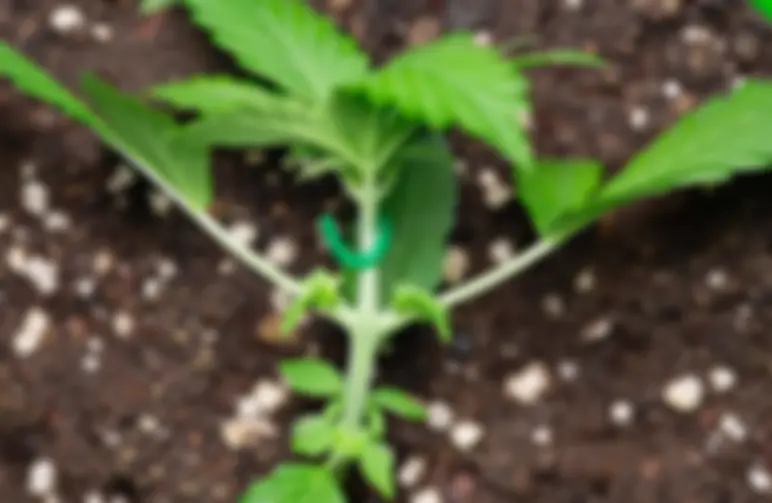If you want your autoflowers to punch above their weight without stressing them out, low-stress training (LST) is the move. We're talking gentle bends, soft ties, and a flat, even canopy that soaks up light like a solar farm.
No chopping tops, no week-long recovery, just smarter shape, better airflow, and chunkier buds.
Here's exactly how we do LST on autos at WeedSeedsExpress, why it works, and how you can start today with minimal gear and maximum confidence.
Key Takeaways
- Low stress training for autoflower strains spreads growth horizontally to break apical dominance, improving light reach, airflow, and delivering roughly 20–50% higher yields.
- Start LST around week 3 when plants have 3–4 nodes and stop new bends by week 4–5 once pistils appear, then maintain a flat, even canopy.
- Make the first bend 45–80° above the 3rd node, tie the apex below side branches, guide out the tallest shoots, and keep defoliation minimal and targeted.
- Run 18/6–20/4 lighting with PPFD 400–600 (LED 18–24 inches), keep temps [23.9:celsius]-[26.7:celsius] with 55–65% RH, and aim for pH 6.0–6.5 in soil or 5.8–6.2 in coco.
- Use soft ties and solid pot anchors on 3–5 gallon final containers, check and loosen ties daily, and splint any accidental cracks before pausing training.
- LST pairs well with a light-touch ScrOG, skip topping for most autos, and choose vigorous, LST-friendly cultivars like Z Auto, Gorilla Glue Auto, or Amnesia Haze Auto.
The Key to Unlocking Your Autoflower's Full Potential
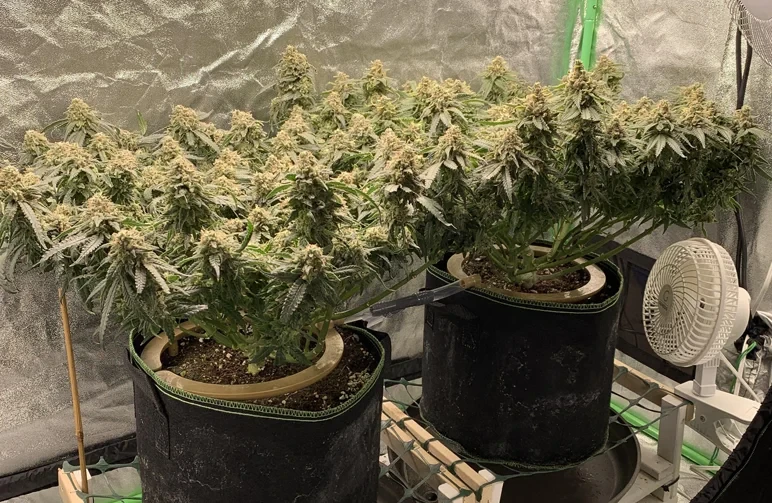
Autoflowers don't have time to waste. Most flip themselves into flower around week 3–4 from sprout, which means every day of veg matters.
While our guide on how to grow autoflowers covers the full lifecycle from seed to harvest, LST is the specific technique that helps you make those vegetative days count.
By gently bending and tying branches to grow horizontally, you create a flat, even canopy. More light hits more bud sites, your plant stays compact, and airflow improves, so you get denser, happier flowers.
Target keyword alert without the cringe: low stress training for autoflower strains gives beginners a safe way to boost yields, especially in small tents or closets.
We'll show you the science, the timing, and the step-by-step method we use in our own test tents.
What is Low-Stress Training (LST)?
Low-stress training is a shaping technique. We guide the plant sideways by bending and tying the main stem and branches so growth spreads out evenly instead of shooting straight up.
Think of it like training a vine along a trellis rather than letting it become a Christmas tree.
The big difference from high-stress techniques (like topping or supercropping): with LST, we avoid damaging the plant. No cutting off the tip, no crushing stems.
Autos don't have spare time to recover from shocks, so we keep it gentle.
Breaking Apical Dominance: The Science Behind LST
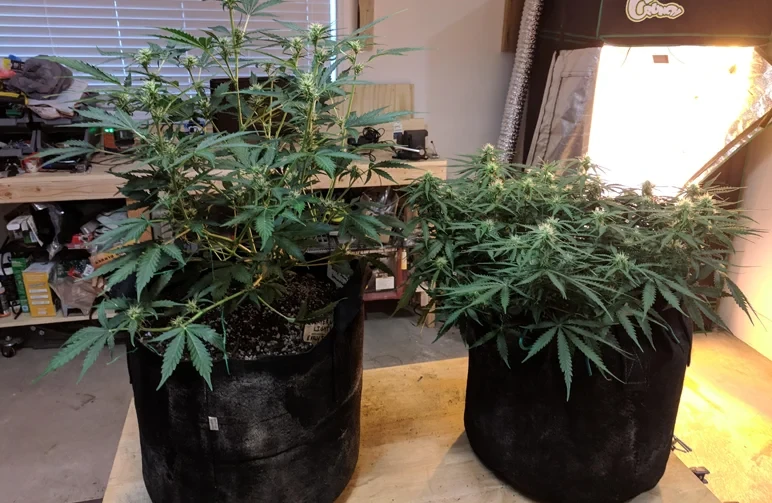
Cannabis naturally favors the top tip (the "apex"). That top tip hoards growth hormones called auxins, basically VIP passes for growth. When we bend the main stem down, we spread those hormones around.
Result: side branches wake up, start growing like mini mains, and you get a table of colas instead of one tall spear.
Why LST is Ideal for Autoflowers
Autoflowers have a short veg phase (usually 3–4 weeks). Stressful moves like topping can stall growth during the exact window you need momentum. LST applies minimal stress, so the plant keeps trucking.
You still get better light distribution and structure, but without the hit to your timeline.
The Benefits of LST for Your Autoflower Grow
- Bigger yields from the same space: A flat canopy means more bud sites sit in the "sweet spot" of your light. We've seen up to 30–50% better yield with solid LST versus a natural Christmas tree shape, strain dependent.
- Denser, more uniform buds: No more tiny popcorn hidden in the shadows. Even light = even development.
- Height control: Perfect for 60 cm-120 cm tents or stealth grows. Keep plants compact without starving them of light.
- Better airflow and lower mold risk: Spreading branches out lets air move through the canopy, critical in humid rooms.
- Simplicity: No fancy gear. Soft ties, patience, done.
When to Start (and Stop) LST on Autoflowers: The Critical Timing
Start: Around week 3 from sprout or when the plant has 3–4 nodes (nodes = sets of leaves on the main stem). The stem is flexible, the roots are anchoring, and you're early enough to shape the structure before flowering ramps.
Stop: When vertical growth slows and distinct buds begin forming, usually end of week 4 to week 5 on many autos. After that, keep the shape but avoid new bends. You can still re-tie to prevent the canopy from "popping up," but no fresh stress.
Pro tip: Bend right after lights-on when plants are turgid but not brittle, or right after watering when tissues are a bit more pliable. If you hear a crack, freeze, support with a plant tape "splint," and don't push your luck for a few days. You probably didn't kill it, but don't double down.
How to LST Autoflowers: A Step-by-Step Guide
Step 1: Gather Your Supplies
Essential Gear:
- Soft Plant Ties: Coated wire or thick pipe cleaners work great. Avoid thin wire or string that can cut into stems.
- Anchors: Fabric pot clips, binder clips for fabric pots, or tent stakes. For plastic pots, a small hand drill to make holes around the rim is perfect.
Environment & Nice-to-Haves:
- Light: 18/6 or 20/4 schedule is standard. Keep PPFD in the 400–600 range for veg. No meter? Aim your LED 18–24 inches above the canopy.
- Temps/RH: 75–80°F (24 °C–27 °C) and 55–65% RH in early veg. A stable environment prevents other stresses.
- Medium pH: 6.0–6.5 in soil; 5.8–6.2 in coco. Learn more about growing in coco here.
- Garden Tape: For those "oops" moments when a stem cracks. This stuff can save a branch.
Step 2: Prepare Your Pot
- Start the plant in its final container. Transplant shock can steal days you don't have. We like 3–5 gallon (11–19 L) fabric pots for most autos.
- Add anchor points. Fabric pots: clip on binder clips and tie to those. Plastic pots: drill small holes around the rim. Anchors let you control direction and tension.
Step 3: The First Bend (The Most Important Step)
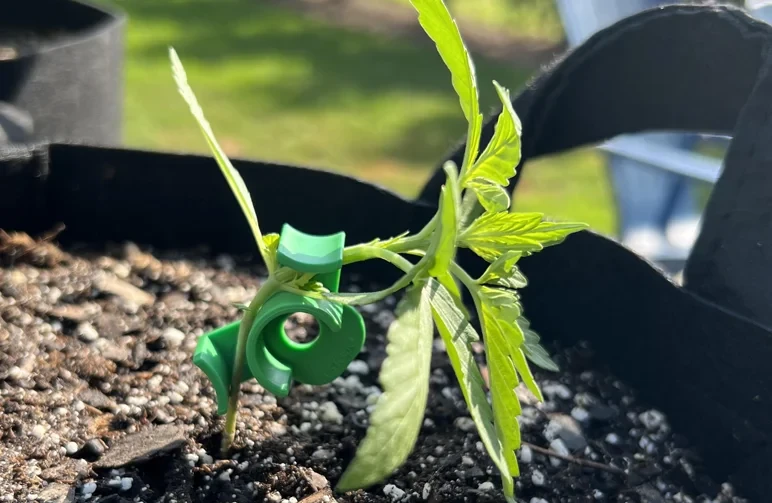
- Find the main stem just above the 3rd node. Hold the base of the stem between two fingers to stabilize—this hand is your "brace."
- Gently pull the top of the plant sideways until it's nearly horizontal. Don't go full pancake: 45–80 degrees is plenty. If the stem feels stiff, do micro-bends over 1–2 minutes instead of one big shove.
- Tie the top to the pot edge using a soft tie. It should be snug, not strangling. The goal is the apex sitting below some of the side branches; this flips the auxin script and wakes those sites up.
What if it snaps? It happens. Wrap the area with plant tape, add a support stake, and stop training for a few days. Autos often heal surprisingly well if you stabilize them quickly.
Step 4: Secure and Shape the Side Branches
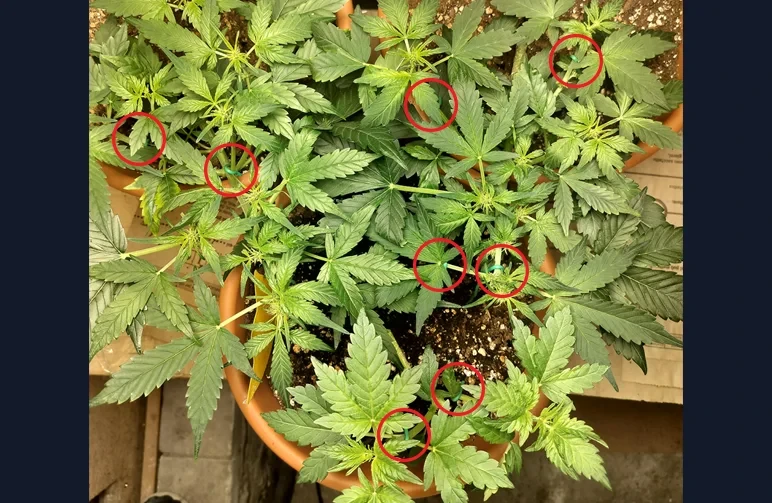
- Over the next few days, you'll see side branches stretch upward toward the light. Pick the tallest ones and gently pull them outward, tying them so all tops are roughly the same height.
- Rotate the pot a quarter turn every day or two to encourage symmetrical growth. Keep creating that "tabletop."
- Remove only leaves that are blocking bud sites and can't be tucked. Minimalist defoliation is the move with autos—2–4 leaves at a time, max, then wait a few days. For more details, check out our guide to defoliating autoflowers.
Step 5: Monitor and Adjust Daily
- Check ties daily. Plants grow fast: ties that were perfect yesterday might be digging in today. Loosen or reposition as needed.
- Keep tops level. If one takes off, tie it lower and let shorter branches catch up. "Even canopy" is your mantra.
- As preflowers appear (little hairs at nodes), stop adding new bends. From here out, it's maintenance: keep the canopy flat, keep airflow strong, and let the plant stack.
4 Common LST Mistakes That Can Wreck Your Autoflower Grow
1. Starting Too Late: This is the #1 rookie error. If you wait until the plant is already stretching into flower (week 5+), the main stem will be woody and stiff. Trying to bend it then is a recipe for a snap.
The Fix: Stick to the golden rule: start when you have 3-4 nodes, usually around week 3.
2. Using the Wrong Ties: Using string, fishing line, or thin uncoated wire is a bad move. As the stem thickens, these can slice right into it, causing damage and creating an entry point for pests and disease.
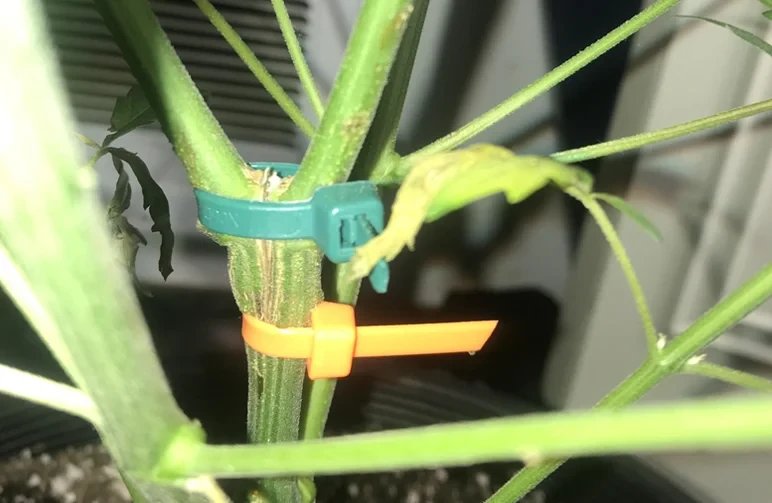
The Fix: Always use soft, coated plant ties or thick, gentle material like pipe cleaners.
3. Bending Too Aggressively: Enthusiasm is great, but trying to bend the plant a full 90 degrees on the first day is asking for trouble. A sudden, hard bend can easily snap a healthy stem.
The Fix: Be gentle. Aim for a 45-degree bend first. You can always increase the tension and angle a day later once the plant has adapted. Patience pays off.
4. "Set It and Forget It": LST isn't a one-time task. A tie that's perfect on Monday might be choking a branch by Friday. If you don't adjust, you'll restrict growth and could even lose a branch.
The Fix: Make it part of your daily check-in. Spend 60 seconds looking at your ties, loosening any that are tight, and guiding new growth.
Combining LST with Other Training Techniques
LST + ScrOG (Screen of Green): Great combo. ScrOG means using a net to hold tops in one plane. For autos, we keep it light-touch: guide tops into the squares during the early stretch, then stop moving them once flowers set.
Don't weave aggressively; you're not knitting a sweater.
LST + SOG (Sea of Green): SOG is running many small plants with minimal veg. LST still helps keep each plant short and efficient, especially under limited headroom.
LST + Topping? For most autos, we say skip it. If you're experienced and your strain is known to be vigorous, you can top once at the 3rd–4th node around day 18–20, but that's expert mode and still a gamble.
LST alone is safer and plenty effective.
Best Autoflower Strains for LST
Most autos respond well to LST, but some are absolute stars—vigorous side branching, sturdy stems, and cooperative internode spacing.
We've had excellent results with:
- Zkittlez Auto: Branchy, fruity, stacks nicely under an even canopy.
- Gorilla Glue Auto: Strong side arms, handles tie-downs like a champ, gassy as ever.
- Amnesia Haze Auto: Tall by nature, LST keeps her civilized and light-hungry.
- Blueberry Auto: Compact, forgiving, perfect for first LST runs.
Looking for reliable genetics? Browse our Autoflower Seeds at WeedSeedsExpress. We hand-test the lines we sell and back germination with our guarantee.
Pro tip: if you see our 2+2 Free promo live, grab your favorites and practice LST across multiple phenos.
LST for Autoflowers FAQ: Answering Your Questions
- Is LST safe for autos? Yes, when done gently. You're guiding, not breaking. If you're ever unsure, do smaller bends over multiple days.
- How much can LST increase yield? With a good light and healthy environment, 20–50% more than an untrained auto is realistic. The flatter the canopy, the better the light use.
- When exactly do I stop? Once you see consistent pistils and early bud formation, usually end of week 4–5. From then on, maintain shape but avoid new stress.
- Should I defoliate during LST? Lightly. Tuck first. If a leaf directly shades a bud and can't be tucked, remove it, but only a few at a time. Autos hate big leaf dumps.
- My plant looks lopsided after the first bend, normal? Totally. Give it 24–48 hours. Side branches will surge upward, and you'll even things out with follow-up ties.
- Can I LST in hydro or coco? Absolutely. In coco, keep pH 5.8–6.2 and feed light but frequent. In hydro, anchors can be trickier; use lid grommets or net pots as tie points.
Conclusion: A Small Effort for a Big Reward
Low stress training for autoflower strains is the definition of smart growing: a few minutes a day to guide shape, and your plant pays you back with fatter, more uniform colas.
Start around week 3, keep it gentle, and aim for that level canopy. Watch the plant, not the calendar.
If you want an easy win for your next run, pair this guide with proven genetics. Grab a vigorous auto from WeedSeedsExpress, set your lights 18/6, keep temps [23.9:celsius]-[26.7:celsius], and start bending.
It's simple, it's safe, and honestly, it works. Happy training, fam.
